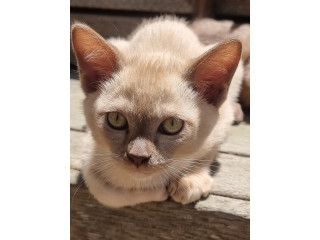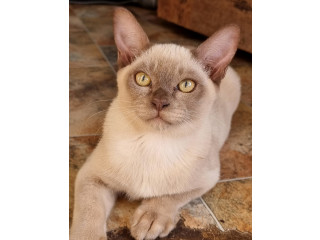Do you have anything to sell or rent?
Sell your products and services online FOR FREE. It is easier than you think!
Start Now!The Burmese thrives on companionship with her humans and other cats. Like her Siamese ancestors, she enjoys conversation, but has a much softer, sweeter voice.
Temperament
She’s energetic, curious and playful well into adulthood and loves interactive toys and learning new tricks. She loves to give and receive attention, so expect her to follow you around, sit on your lap and snuggle next to you in bed. Guests will be surprised by her outgoing, dog-like nature.
Characteristics
Their compact body is solid and muscular with a rounded head and sweet, expressive eyes. Their ears are medium sized, with rounded tips that tilt slightly forward.
Lifespan
10 to 16 years
Colors
The original Burmese cat was sable, a solid, dark brown color. Newer lines of Burmese come in several other shades, including blue, champagne and platinum, and some associations even permit tortoiseshell, lilac and red to be shown. Sable kittens’ coats darken as they mature and all colors have green or golden eyes, depending on their coat color.
Shedding
Shedding is minimal and weekly brushing will keep your Burmese cat’s coat healthy and shiny by removing loose hair and redistributing skin oils.
Health
Burmese cats are prone to gingivitis and are sensitive to anesthesia. Other diseases and deformities have been seen in the breed, including:
- Corneal dermoid
- Orofacial pain syndrome
- Congenital peripheral vestibular disease
- Craniofacial abnormalities
- Hypokalemic polymyopathy
- Flat-chested kitten syndrome
- Kinked tail
- Elbow osteoarthritis
- Diabetes
- And more
Choosing the Best Food for Burmese Cats
When it comes to feeding your Burmese cat, choose a complete and balanced cat food to support her playful and active nature. Indoor cats may need a specially formulated food to help maintain a healthy weight and control hairballs.
Choosing the Best Food for Burmese Kittens
Your Burmese kitten needs a complete and balanced kitten food with all the nutrients essential to her growth and development. During her first year, select a kitten food to support her maturation into adulthood.
History
Dr. Joseph Thompson brought the first Burmese cat to America in 1930. Her name was “Wong Mau” and she was bred with Siamese cats. Through selective breeding, Thompson was able to achieve the sable coat color and isolate it for further breeding.
The breed was registered with the Cat Fanciers Association (CFA) in 1936, but registration was suspended in 1947 because Siamese cats were still being used in breeding programs. Once this practice was eliminated, registrations resumed in 1953. The Burmese cat was accepted by The International Cat Association (TICA) in 1979.
Facts
- The Burmese cat resulted from a cross of the Siamese with the “copper cat” of Burma (present-day Myanmar).
- They may have been kept by priests in temples and palaces.
- The Burmese was one of the original breeds accepted by TICA.


